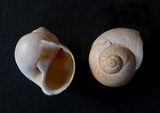
Euspira catena
Encyclopedia
Euspira catena, previously known as Natica catena, common name
the large necklace shell, is a medium-sized species
of predatory sea snail
, a marine
gastropod mollusc in the family
Naticidae
, the moon snails.
.jpg) The rounded shell is thin and polished and brownish-yellow, with a row of reddish markings just below the suture of the last whorl. It can grow to about 3 cm (1 in) and has a short spire and seven rounded whorls separated with distinct sutures. The lowest whorl occupies about 90% of the volume. It has a large umbilicus and the operculum
The rounded shell is thin and polished and brownish-yellow, with a row of reddish markings just below the suture of the last whorl. It can grow to about 3 cm (1 in) and has a short spire and seven rounded whorls separated with distinct sutures. The lowest whorl occupies about 90% of the volume. It has a large umbilicus and the operculum
is ear-shaped and spirally wound. The foot is cream coloured and very large, partially covering the shell when the animal is moving. The head has two long flattened tentacles and a short snout with extensible proboscis
. The large necklace shell might be confused with a similar but smaller species, the common necklace shell (Euspira pulchella
).
to the Skagerrak
.
to depths of 125 metres. It feeds on bivalve molluscs, penetrating their shells with its proboscis and sucking out the contents.
Egg capsules are laid in a spirally wound collar of jelly embedded with sand grains. The remains of these may be found on the beach.
Common name
A common name of a taxon or organism is a name in general use within a community; it is often contrasted with the scientific name for the same organism...
the large necklace shell, is a medium-sized species
Species
In biology, a species is one of the basic units of biological classification and a taxonomic rank. A species is often defined as a group of organisms capable of interbreeding and producing fertile offspring. While in many cases this definition is adequate, more precise or differing measures are...
of predatory sea snail
Snail
Snail is a common name applied to most of the members of the molluscan class Gastropoda that have coiled shells in the adult stage. When the word is used in its most general sense, it includes sea snails, land snails and freshwater snails. The word snail without any qualifier is however more often...
, a marine
Marine (ocean)
Marine is an umbrella term. As an adjective it is usually applicable to things relating to the sea or ocean, such as marine biology, marine ecology and marine geology...
gastropod mollusc in the family
Family (biology)
In biological classification, family is* a taxonomic rank. Other well-known ranks are life, domain, kingdom, phylum, class, order, genus, and species, with family fitting between order and genus. As for the other well-known ranks, there is the option of an immediately lower rank, indicated by the...
Naticidae
Naticidae
Naticidae, common name the moon snails, is a family of minute to large-sized predatory sea snails, marine gastropod molluscs in the clade Littorinimorpha.Naticidae is the only family in the superfamily Naticoidea....
, the moon snails.
Description
.jpg)
Operculum (gastropod)
The operculum, meaning little lid, is a corneous or calcareous anatomical structure which exists in many groups of sea snails and freshwater snails, and also in a few groups of land snails...
is ear-shaped and spirally wound. The foot is cream coloured and very large, partially covering the shell when the animal is moving. The head has two long flattened tentacles and a short snout with extensible proboscis
Proboscis
A proboscis is an elongated appendage from the head of an animal, either a vertebrate or an invertebrate. In simpler terms, a proboscis is the straw-like mouth found in several varieties of species.-Etymology:...
. The large necklace shell might be confused with a similar but smaller species, the common necklace shell (Euspira pulchella
Euspira pulchella
Euspira pulchella is a species of sea snail, a marine gastropod mollusc in the family Naticidae, the moon snails.-Distribution:...
).
Distribution
The large necklace shell is found on the coasts of north west Europe, from the Mediterranean SeaMediterranean Sea
The Mediterranean Sea is a sea connected to the Atlantic Ocean surrounded by the Mediterranean region and almost completely enclosed by land: on the north by Anatolia and Europe, on the south by North Africa, and on the east by the Levant...
to the Skagerrak
Skagerrak
The Skagerrak is a strait running between Norway and the southwest coast of Sweden and the Jutland peninsula of Denmark, connecting the North Sea and the Kattegat sea area, which leads to the Baltic Sea.-Name:...
.
Biology
The large necklace shell lives buried in the sand and gravel of the lower shore and the neritic zoneNeritic zone
The neritic zone, also called coastal waters, the coastal ocean or the sublittoral zone, is the part of the ocean extending from the low tide mark to the edge of the continental shelf, with a relatively shallow depth extending to about 200 meters...
to depths of 125 metres. It feeds on bivalve molluscs, penetrating their shells with its proboscis and sucking out the contents.
Egg capsules are laid in a spirally wound collar of jelly embedded with sand grains. The remains of these may be found on the beach.

